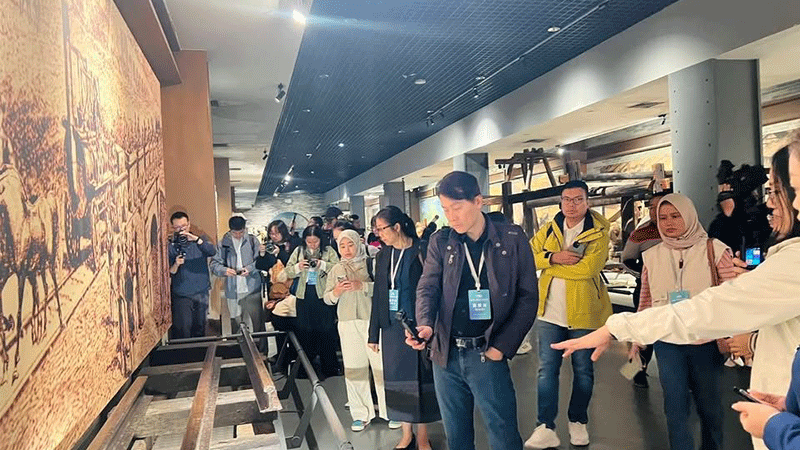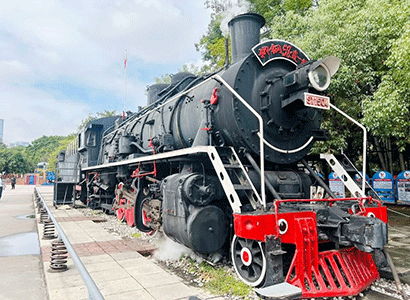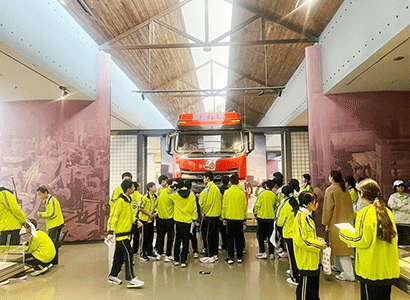 |
| Visitors learn about the development of industry in Liuzhou. |
Exploring the past, present and future of industry at Liuzhou’s Industrial Museum
In the very heart of Liuzhou stands a magnificent monument to human ingenuity and the city’s enduring spirit: the Liuzhou Industrial Museum. Forget any image of a dusty repository of forgotten relics; this is a vibrant cultural anchor, telling the dynamic, 100-plus-year story of Liuzhou as an industrial powerhouse.
The museum’s journey, housed within the dramatic transformation of the former Liuzhou Third Cotton Textile Mill, perfectly mirrors the city’s own incredible evolution into a National First-Class Museum.
As Ms Zhuangyan, the deputy director, proudly said, it is “the nation’s first comprehensive urban industrial museum”. This unique institution not only chronicles more than a century of Liuzhou’s industrial prowess but, crucially, showcases the city’s commitment to the future.
With an immense collection of over 34,000 industrial artefacts and an astonishing peak daily visitor count of up to 30,000, the museum’s annual attendance comfortably exceeds 1.5 million people, confirming its status as a cultural powerhouse.
 |
 |
| An old steam train on display outside the Liuzhou Industrial Museum. |
Ms Zhuangyan, Deputy Director of the Liuzhou Industrial Museum. |
The sheer scale of the museum is impressive, spanning a total area of 110,000 square metres.
Its global significance is clear, having been included in UNESCO’s “Museums for All: Innovative Practices in Accessibility and Inclusion” case list. Inside, a monumental collection of over 6,400 industrial relics, including multiple sets of national-grade cultural relics, offers visitors a tangible, powerful look at the city’s deep industrial history since 1902.
However, the Liuzhou Industrial Museum is keenly aware that simply displaying artefacts isn’t enough to capture modern imaginations. Ms Zhuangyan detailed a powerful, forward-thinking strategy for revitalising and utilising its resources.
Spatial Revitalisation: The museum has truly made the most of its vast space. By expanding beyond its three main halls to include the Industrial Retro Hall and quirky outdoor venues like the Train Book Café, it ensures a comprehensive and utterly immersive visitor experience.
Dynamic Engagement: Technology is key to transforming static exhibits. Ms Zhuangyan said”We bring the artefacts displayed... to life through methods such as AI, 3D animations, and immersive performances, making the collections more dynamic and engaging.”
Expanded Functionality: Crucially, the museum has developed over 100 educational programmes across 10 categories, effectively becoming a “second classroom for teenagers”.
“As the nation’s first comprehensive urban industrial museum, we house over 34,000 industrial artefacts, but our mission extends beyond preservation; we’re actively revitalising these resources, integrating tourism, and transforming the museum into a dynamic second classroom for the next generation,” Ms Zhuangyan said.
 |
 |
| |
School children tour the Liuzhou Industrial Museum. |
The spirit of innovation, meticulously preserved in the museum’s halls, is very much alive on Liuzhou’s streets and production lines, proving that the city’s foundational history directly supports global-scale output today.
Automotive Power (SGMW): The legacy of skilled engineers and artisans directly drives the success of SAIC-GM-Wuling Automobile Co., Ltd. (SGMW). With cumulative sales exceeding 30 million vehicles and New Energy Vehicle (NEV) sales ranking third globally, SGMW is a true market transformer. Their NEV sales recently topped 100,000 units in a single month, demonstrating Liuzhou’s critical role as a major engine for global electric mobility.
Global Heavy Machinery (LiuGong): The history of robust, reliable manufacturing is embodied by Guangxi LiuGong Machinery Co., Ltd. Having introduced China’s first modern wheel loader back in 1966, LiuGong now boasts 20 manufacturing facilities and a vast network of over 500 dealers in 180 countries, operating in environments from the Sahara to the Antarctic.
The Taste of Success (Luosifen): Even the food industry is a testament to Liuzhou’s industrial ingenuity. Guangxi No. Wang Food Company has used industrial scaling—a clever raw materials + central kitchen + e-commerce sales model—to elevate Luosifen from a local delicacy to a global sensation. The company has been recognised as “No. 1 in Export Value in China’s Luosifen Market for 5 Consecutive Years”, a triumph where local flavour meets global commerce.
This powerful industrial narrative is beautifully balanced by Liuzhou’s distinctive cultural charm.
The ancient streets of Yaobu Old Town, the city’s “oldest wharf”, dating back over 2,000 years, offer a vibrant cultural hub complete with lively markets and spectacular nightly light shows. Recognised as a national-level Nighttime Cultural and Tourism Agglomeration Area, it perfectly blends history with contemporary flair.
The Liuzhou Industrial Museum is far more than a destination; it’s a vital cultural experience that proves Liuzhou is a city of movers and makers, successfully transitioning from a cotton mill past to a globally recognised future in manufacturing, food and culture.
By Keoxomphou Sakdavong
(Latest Update November 12, 2025)
|






